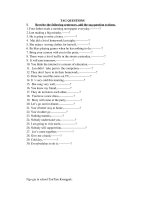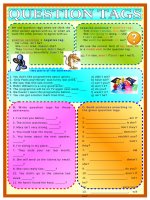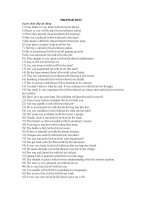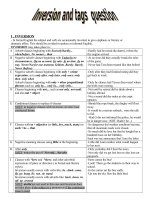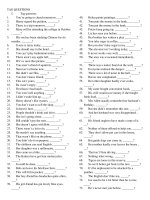tag question_either_Both
Bạn đang xem bản rút gọn của tài liệu. Xem và tải ngay bản đầy đủ của tài liệu tại đây (285.27 KB, 14 trang )
III/ CÂU HỎI ĐUÔI :**Trong câu hỏi đuôi, người đặt câu hỏi đưa ra một mệnh đề (mệnh đề chính)
nhưng không hoàn toàn chắc chắn về tính đúng / sai của mệnh đề đó, do vậy họ dùng câu hỏi dạng này để
kiểm chứng về mệnh đề đưa ra.
He should stay in bed, shouldn't he? (Anh ấy nên ở yên trên giường, có phải không?)
She has been studying English for two years, hasn't she?
There are only twenty-eight days in February, aren’t there?
It’s raining now, isn’t it? (Trời vẫn còn mưa, phải không?)
You and I talked with the professor yesterday, didn’t we?
You won’t be leaving for now, will you?
Jill and Joe haven’t been to VN, have they?
* Câu hỏi đuôi chia làm hai thành phần tách biệt nhau bởi dấu phẩy theo quy tắc sau:
• Sử dụng trợ động từ giống như ở mệnh đề chính để làm phần đuôi câu hỏi. Nếu không có trợ động
từ thì dùng do, does, did để thay thế.
• Nếu mệnh đề chính ở thể khẳng định thì phần đuôi ở thể phủ định và ngược lại.
• Thời của động từ ở đuôi phải theo thời của động từ ở mệnh đề chính.
• Chủ ngữ của mệnh đề chính và của phần đôi là giống nhau. Đại từ ở phần đuôi luôn phải để ở
dạng chủ ngữ (in subject form)
• Phần đuôi nếu ở dạng phủ định thì thường được rút gọn (n’t). Nếu không rút gọn thì phải theo thứ
tự: auxiliary + subject + not? (He saw it yesterday, did he not?)
• Động từ have có thể là động từ chính, cũng có thể là trợ động từ. Khi nó là động từ chính của
mệnh đề trong tiếng Anh Mỹ thì phần đuôi phải dùng trợ động từ do, does hoặc did. Tuy nhiên, trong
tiếng Anh Anh thì bạn có thể dùng chính have như một trợ động từ trong trường hợp này. Khi bạn thi
TOEFL là kỳ thi kiểm tra tiếng Anh Mỹ, bạn phải chú ý để khỏi bị mất điểm.
You have two children, haven’t you? (British English: OK, TOEFL: NOT)
You have two children, don't you? (Correct in American English)
There is, there are và it is là các chủ ngữ giả nên phần đuôi được phép dùng lại there hoặc it giống như
trường hợp đại từ làm chủ ngữ.
*Qui tắc cơ bản: xác định,phủ định?
Ex1:Tom is a student,isn't he?
Ex2:Tom doesn't work hard,does he?
*khi trong câu chứa các từ: nobody,no one,nothing,never,hardly, scarcely,little… thì được xem là câu phủ
định ---> câu hỏi đuôi phía sau ta phải dùng xác định
Ex: She never goes to paties,does she?
Ex: He had seldom seen a child with so much talent, had he?
*khi chủ từ trong câu là các đại từ bất định như:anyone,anybody,no one,none,neither,somebody
someone,none,nobody,everybody,everyone ---> chủ từ trong câu hỏi đuôi ta phải dùng they
Ex: Everyone is ready,aren't they?
*Everything,nothing,something---> chủ từ trong câu hỏi đuôi dùng it
Ex:Something in the machine was wrong,wasn't it?
* khi chủ từ trong câu là that, this --- > chủ từ trong câu hỏi đuôi là it
*các dạng đặc biệt:
+ câu hỏi đuôi của there là there:
Ex: there ảe tow people waiting for us óutide, aren’t there?
+câu mệnh lệnh thì phần câu hỏi đuôi ta dùng will you
Ex: open the door, will you?
+ khi câu ở phía trước là Let's thì phần câu hỏi đuôi phía sau phải là shall we
Ex: let's go shopping,shall we?
+khi trong câu trước là I am thì câu hỏi đuôi phải dùng aren't I (không dùng am i not?)
Ex: I 'm late,aren't I ?
•
1
positive statement [+] negative tag [-]
notes:
subject auxiliary main
verb
auxiliary not Personal,pronoun
(same as subject)
You are coming, are n't you?
We have finished, have n't we?
You do like coffee, do n't you?
You like coffee, do n't you?
You (do) like...
They will help, wo n't they?
won't = will not
I can come, can 't I?
We must go, must n't we?
He should try harder, should n't he?
You are English, are n't you?
John was there, was n't he?
Look at these examples with negative statements:
negative statement [-] positive tag [+]
subject auxiliary main verb auxiliary personal
pronoun
(same as subject)
It is n't raining, is it?
We have never seen that, have we?
You do n't like coffee, do you?
They will not help, will they?
They wo n't report us, will they?
I can never do it right, can I?
We must n't tell her, must we?
He should n't drive so fast, should he?
You are n't English, are you?
2
John was not there, was he?
Some special cases:
I am right, aren't I? aren't I (not amn't I)
You have to go, don't you? you (do) have to go...
I have been answering, haven't
I?
use first auxiliary
Nothing came in the post, did it? treat statements with nothing, nobody etc like negative
statements
Let's go, shall we? let's = let us
He'd better do it, hadn't he? he had better (no auxiliary)
Here are some mixed examples:
• But you don't really love her, do you?
• This will work, won't it?
• Well, I couldn't help it, could I?
• But you'll tell me if she calls, won't you?
• We'd never have known, would we?
• The weather's bad, isn't it?
• You won't be late, will you?
• Nobody knows, do they?
Notice that we often use tag questions to ask for information or help, starting with a negative statement.
This is quite a friendly/polite way of making a request. For example, instead of saying "Where is the
police station?" (not very polite), or "Do you know where the police station is?" (slightly more polite), we
could say: "You wouldn't know where the police station is, would you?" Here are some more examples:
• You don't know of any good jobs, do you?
• You couldn't help me with my homework, could you?
• You haven't got $10 to lend me, have you?
Intonation
We can change the meaning of a tag question with the musical pitch of our voice. With rising intonation, it
sounds like a real question. But if our intonation falls, it sounds more like a statement that doesn't require a
real answer:
intonation
You don't know where my wallet is, do you? / rising real question
It's a beatiful view, isn't it? \ falling not a real question
Trả lời cho câu hỏi đuôi:
Thương thì chúng ta chỉ cần nói Yes hoặc No. trong một số trường hợp chúng ta có thể trả lời bằng phần đuôi ( …, do they?
Yes ,they do). Cần cẩn thận trong việc trả lời 1 số trường hợp:
How do we answer a tag question? Often, we just say Yes or No. Sometimes we may repeat the tag and
reverse it (..., do they? Yes, they do). Be very careful about answering tag questions. In some languages,
an oposite system of answering is used, and non-native English speakers sometimes answer in the wrong
way. This can lead to a lot of confusion!
3
Answer a tag question according to the truth of the situation. Your
answer reflects the real facts, not (necessarily) the question.
For example, everyone knows that snow is white. Look at these questions, and the correct answers:
In some languages, people answer a question like "Snow isn't black, is it?" with "Yes" (meaning "Yes, I
agree with you"). This is the wrong answer in English!
Here are some more examples, with correct answers:
• The moon goes round the earth, doesn't it? Yes, it does.
• The earth is bigger than the moon, isn't it? Yes.
• The earth is bigger than the sun, isn't it? No, it isn't!
• Asian people don't like rice, do they? Yes, they do!
• Elephants live in Europe, don't they? No, they don't!
• Men don't have babies, do they? No.
• The English alphabet doesn't have 40 letters, does it? No, it doesn't.
Question tags with imperatives
Sometimes we use question tags with imperatives (invitations, orders), but the sentence remains an
imperative and does not require a direct answer. We use won't for invitations. We use can, can't, will,
would for orders.
imperative + question tag notes:
invitation Take a seat, won't you? polite
order Help me, can you? quite friendly
Help me, can't you? quite friendly (some irritation?)
Close the door, would you? quite polite
Do it now, will you? less polite
Don't forget, will you? with negative imperatives only will is possible
Same-way question tags
Although the basic structure of tag questions is positive-negative or negative-positive, it is sometime
possible to use a positive-positive or negative-negative structure. We use same-way question tags to
express interest, surprise, anger etc, and not to make real questions.
• So you're having a baby, are you? That's wonderful!
• She wants to marry him, does she? Some chance!
• So you think that's amusing, do you? Think again.
Negative-negative tag questions usually sound rather hostile:
• So you don't like my looks, don't you?
Câu hỏi đuôi (Tag questions):A tag question is a special construction in English. It is a statement
followed by a mini-question. The whole sentence is a "tag question", and the mini-question at the
end is called a "question tag". We use tag questions at the end of statements to ask for
confirmation. They mean something like: "Am I right?" or "Do you agree?" They are very common
in English.
Trong câu hỏi đuôi, người đặt câu hỏi đưa ra một mệnh đề (mệnh đề chính) nhưng không
hoàn toàn chắc chắn về tính đúng / sai của mệnh đề đó, do vậy họ dùng câu hỏi dạng này để
kiểm chứng về mệnh đề đưa ra.
He should stay in bed, shouldn't he? (Anh ấy nên ở yên trên giường, có phải không?)
She has been studying English for two years, hasn't she?
4
There are only twenty-eight days in February, aren’t there?
It’s raining now, isn’t it? (Trời vẫn còn mưa, phải không?)
You and I talked with the professor yesterday, didn’t we?
You won’t be leaving for now, will you?
Jill and Joe haven’t been to VN, have they?
Neither John nor his friends are going to the beach today.
Either John or his friends are going to the beach today.
Neither the boys nor Carmen has seen this movie before.
Either John or Bill is going to the beach today.
Neither the director nor the secretary wants to leave yet
Bài 1 : Either – Neither – Both – Not only …. But also
A- Đặc điểm:
*Either = hoặc cái này, hoặc cái kia, hoặc người này hoặc người kia.
*Neither = Không phải cái này mà cũng không phải cái kia, không phải người này mà không phải người kia.
*Both = cả hai
Có một số điểm giống nhau:
a> 3 từ nói trên chỉ có thể dùng để chỉ hai người hoặc hai vật, không thể chỉ ba người hay ba vật trở lên.Either shirt is OK : cái áo sơmi nào
cũng được (nghĩa là cái này hay cái kia đều được)
I like neither of them : tôi không thích người nào cả (trong số hai người)
They are both too young to go to school : cả hai đứa đều còn nhỏ quá chưa đi học được.
b> 3 từ nói trên đều có thể dùng như một tính từ, đại từ hay liên từ
+ Tính từ :Neither student is good at maths.
There are trees on either side of this treet.
Both these girls are married.
+ Đại từ Either (of them) can swim.
Neither (of them) has a bicycle.
I kow both (of them).
+ Liên từ:He neither drinks nor smokes
A bird may be either shot or trapped
The statue of Liberty was both designed and presented to the American people by the sculptor Auguste Bartholdi.
Trong phần liên từ này ta có thể kể thêm tương liên từ (correlative) not only…but also… (không những….mà còn….
Vì cấu trúc gần giống như các liên từ = either…or…,neither…nor…, và both… and…).
Riêng về trạng từ, thì “either” “neither” có khi được dùng ở vị trí trạng từ, nhưng “both” thì không. Trái lại “both” có thể lảm nhiệm vụ đồng vị
khi chủ ngữ là một đại từ nhân xưng.:
We both cut ourselves while shaving.
Từ đồng vị “both” cũng có thể đứng giữa một trợ từ và động từ chính hay sau động từ “to be”.
They can both swim well
You are both late.
They have both gone to market.
B- Cấu trúc
Tính từ: tính từ mô tả, nhất là tính từ chỉ màu sắc, thường có 2 chức năng: bổ ngữ (C), định ngữ (M). Tuy nhiên có 1 số tính từ trong đó có
either, neither, both, chỉ làm định ngữ mà thôi. Là định ngữ, 3 tính từ này đều đứng trước danh từ số ít.
a) EITHER & NEITHEREither tourist speaks English.
Neither umbrella is mine.
Either student is good at maths, aren’t they?
Neither person witnessed the accident, did they?
Từ những ví dụ trên chúng ta có thể rút ra những kết luận về cách dùng “either” & “neither”
- Danh từ mà “either”, “neither” thêm nghĩa, không bao giờ có mạo từ “a”, “an” đứng trước, cho dù danh từ ấy là một danh từ đếm được.
-“Either”, “neither” cúng không chấp nhận mạo từ “the”, “this”, “that” hay một tính từ sở hữu nào đó.
- “Either”, “neither” chỉ thêm nghĩa cho danh từ số ít, do đó khi danh từ là chủ ngữ thì động từ ở số ít. Tuy nhiên, trong tiếng Anh hiện đại, khi
danh từ ấy bao gồm cả nam lẫn nữ, thì đại từ thay thế phải ở số nhiều. Tính từ sở hữu của danh từ ấy cũng ở số nhiều:
o Either student left their books behind
b) BOTH
Both students were wearing uniforms.
Both these/those/our houses are in Dien Bien Phu st.
We both agreed to his proposal.
We can both cook well
They were both late.
Qua những ví dụ trên chúng ta nhận xét có gì khác nhau giữa BOTH, EITHER, NEITHER
- “Both” luôn ở số nhiều. Do đó danh từ mà “both” thêm nghĩa cũng luôn ở số nhiều, nếu là một danh từ đếm được.
- Danh từ đi sau “both” có thể có mạo từ “the”, tính từ chỉ định (determinative) như “these”, “those”, hay tính từ sở hữu như “my”, “your”… đi
trước. Nhưng các từ đi trước này lại đứng sau “both”, mặc dù “both” là một tính từ.
- “Both” không có chức năng trạng từ, nhưng có thể làm từ đồng vị cho đại từ chủ ngữ. Là từ đồng vị “both” có thể đứng trước động từ chia
rồi, sau “to be”, giữa trợ từ và động từ chính.
Trạng từ: She can’t climb the mountain and he can’t EITHER.
I wasn’t at the beauty contest and NEITHER was she.
Thuy didn’t have her hair cut, NEITHER did her brother.
A: I shan’t go overseas next month.
B: I shant’t EITHER/ NEITHER shall I.
Từ các ví dụ trên ta có thể thấy, EITHER và NEITHER khi được dụng như một trạng từ thì chỉ có thể sử dụng ở thể phủ định.
a) EITHER (Adv)
5

